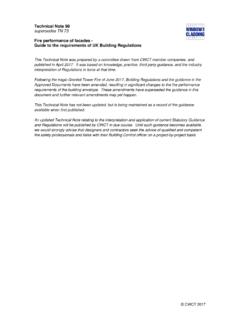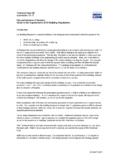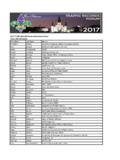Transcription of Chapter 2 Principles of weathertightness
1 CWCT curtain WALL INSTALLATION HANDBOOK Chapter 2 Principles of weathertightness The CWCT is sponsored by:Ove Arup & PartnersBovis Lend Lease LtdComar Architectural Aluminium Systems LtdCouncil for Aluminium in BuildingKawneer UK LtdPilkingtonTechnalTaywood EngineeringUniversity of Bath All rights reserved. No part of this publication may be reproduced or transmitted in any form or by any meansincluding photocopying and recording without the written permission of the copyright holder, application for whichshould be addressed to the publisher. Such written permission must be obtained before any part of thispublication is stored in a retrieval system of any nature. Centre for Window and Cladding Technology November 2001 ISBN 1 874003 96 3 Published by Centre for Window and Cladding Technology, University of Bath, Claverton Down, Bath BA2 7 AYThis handbook was part-funded by the Department of the Environment, Transport and the Regionsunder research contract number 39/03/272 cc 862.
2 This handbook was written by the Centre for Window and Cladding Technology (CWCT) aspart of its training programme to improve the standard of curtain wall installation. It will be of benefit to all those installing, or supervising, the installation of curtain walling andother glazed building elements. This is one of eight chapters from the CWCT Installers handbook. 1 The fa ade 2 Principles of weathertightness 3 Frames 4 Gaskets 5 Sealants 6 Finishes 7 Glass 8 Brackets and fixings Introduction The installation of facades and fa ade elements is one of the more complex operations on aconstruction site. It requires a range of skills and knowledge yet has not been recognised as aparticular skill or trade. Fa ade failure, particularly water leakage, is the most common cause offailure in new buildings. This handbook brings together advice on installation of curtain walling including all the majorcomponents: frames, gaskets, sealants, finishes, glass and fixings.
3 It is based on experience gainedby CWCT in setting up training centres for installers and in training main contractors site supervisors. The book explains why things should be done and highlights those things that are most critical to thesuccess of curtain wall and window installation. This Handbook is a guide to achieving better curtain wall installation. However, it is not a substitute forcare and diligence, nor should it be a substitute for proper training. Full details of CWCT s trainingprogramme are available at 2/42 Principles of weathertightness Water and air tightnessIt is important that a facade keeps out the rain and the wind. Walls are designed to resist wind loadingappropriate to the site and to provide water penetration resistance corresponding to that are designed to achieve the required low levels of air leakage. The allowable leakage isdetermined by the specifier and will depend on the use for which the building is designed, whether ornot it is air-conditioned and the assumptions made when designing the heating systems.
4 Excess airleakage gives rise to increased heating costs and possibly an inability to heat the building fully. Water penetrationWater should not penetrate the wall and reach the inner surface of the wall. It is also unacceptable forwater to penetrate partly through the wall if it causes damage (rot or corrosion) to the wall or reducesits performance (reduction of thermal insulation).A wall may be designed and constructed so that water can enter into the wall but is then drained safelyto the outside. Water management rather than watertightness is the secret to constructing a will penetrate the wall wherever there is an opening, water and a mechanism to take the waterthrough the opening. How water penetrates a wallWater may penetrate a wall or component in one of six basic ways:-Gravity- Wind pressure- Air borne- Kinetic energy- Surface tension- Capillary actionThese are illustrated in Figure Very often it is a combination of factors that causes installation can allow water to enter by any of these mechanisms even if the wall is designedto prevent water to lap components such as flashings, wrongly fitted gaskets and poor sealant joints will allcreate openings that allow water to flow into the wall under gravity.
5 If drainage paths are blockedwater will pond and overflow (often into the wall) under the effect of to seal openings that should be sealed and the incorrect fitting of gaskets leaves openingsthrough which the wind can force to install air seals correctly allows air to pass through the wall and this may carry water into of drips and nibs from the underside of components can allow water to remain attached tothe surfaces and run into the wall as a result of surface tension. Leakage pointsChapter 2/5 Gravity is the most serious cause of water leakage followed by the effects of wind pressure. Both canallow large volumes of water to flow continuously. The other causes of leakage allow only intermittentflow or small risk of leakage is greater at places on the wall where there is most water or greatest points at which water leakage is mostly likely to occur are shown in Figure Water is drivenacross the facade by the wind.
6 It gathers at the mullions and runs down to the corner of each passing a building moves around and over the building. This movement of the wind depositsmore intense rain on the edges of the facade. Wind moving upwards on the wall can drive rain up thewall, particularly on the upper levels of medium and high rise buildings. Drainage openings can bedesigned to cope with this. Water may leak past gaskets and seals at the head of a frame if the jointsare not correctly should never be assumed that a joint is in a protected position and that it is not an important use of picture frame gaskets avoids the need to make mitre or butt joints of gaskets on site. Forms of constructionWalls have to be sealed against air leakage and water has to be prevented from penetrating the many walls and components the air seal is separate from the water outer water barrier, or rainscreen, prevents large amounts of water entering the wall orcomponent.
7 A cavity in the wall or component frame intercepts the small amount of water that passesthe water barrier. An inner air barrier or air seal is provided behind the cavity to give the required lowlevel of air water barrier is designed to prevent water leakage. It is the primary defence against waterleakage and should be constructed with this in mind. Any small amounts of water that enter the cavityhave to be drained to the outer face of the outer layer may be impermeable such as an aluminium or glass panel or it may be porous suchas brick or terracotta. Drained facadesWith the exception of front sealed construction, all framing members and cavities behind rainscreenpanels should be designed to be drained. This means that water passing the outer seal has to drainout through drainage openings to the outer may occur at open joints between panels or through drainage paths in the framing frames are normally drained through holes in the outer face of the frame.
8 An opening sashmay have drainage holes in its lower edge. These drain water from the glazing cavity into the cavitybelow. This in turn has to be drained to the outer face, Figure curtain walling systems may be drained in the same way as windows. Each glazing rebate isdrained to the outer face with holes in the front face of the lower framing member, Figure systems may be designed to drain water along the transom to the mullions, Figure drainage capacity of these systems is limited and water should be drained from the mullion atevery third is important that drainage channels are not blocked as the wall is installed. Badly placed glazingblocks, use of sealants in the wrong place, debris left in the glazing rebate or inadequate or missingdrainage holes can all block the intended drainage 2/6 Water will not drain freely from very small openings due to the effect of surface tension.
9 Drainageholes should be at least 8mm diameter or 25mm x 6mm. Holes that are partially blocked or notproperly deburred will not allow water to drain. Glazing blocks should bridge the drainage channel inthe glazing rebate unless drainage holes are provided between all glazing blocks. Water will not drainfor long distances along horizontal frames, particularly if they deflect under load. Many designs set amaximum distance between drainage holes. Drained and ventilated facadesDrained rainscreen and glazing frames have drainage holes at the bottom of each cavity to allow waterout. Holes may also be provided at the top of the cavity to provide ventilation of the cavity. This allowsair to pass through the cavity or frame to remove excess water for ventilation may be smaller than drainage holes. They are normally made the same size asdrainage holes and placed in symmetrical positions so that transoms cannot be installed upside transoms have holes for only one glazing rebate it should be assumed that they are drainage transom should be placed with the drainage holes uppermost so that they are at the lowest pointof the glazing rebate they drain.
10 Pressure equalised facadesPressure equalised windows and walls are designed with openings large enough to allow the airpressure in the cavities to nearly balance that of the wind on the outside. This helps to prevent waterfrom entering the a rainscreen the drainage and ventilation holes may be larger than for a simply drained andventilated system. Pressure equalised window frames do not always need larger holes. It is notobvious on site whether a window is pressure equalised or only drained and a seal is shown it should be assumed that all holes, including ventilation holes, are necessaryto prevent water penetration into the a glazing rebate is vented into the cavity between an opening frame and a fixed frame then theoutermost vent or drain holes will be larger than the inner ones. This is because they have to allowpressurisation of the two cavities, Figure WindowsWindows are tested to BS5368 Pt 1 for watertightness and BS5368 Pt 2 for airtightness.















